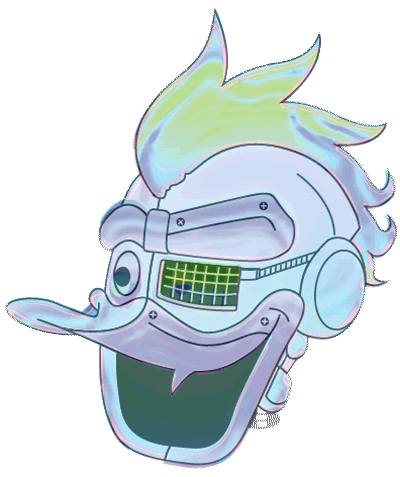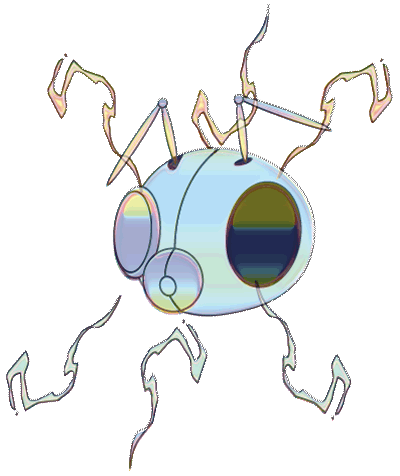



How often (normally after a software or hardware failure) have you screamed at your computer and wished it could hear your anger? Amy Alexander’s Scream is a piece of software art whose key strength is in its simplicity. A relatively small application (2 MB, PC only) rewards the user with a small icon on the taskbar that is the only sign of the software waiting for sound input. When it detects a scream, all active windows become suddenly agitated: flickering or shivering in fear, running away and hiding. The effect is startling – not just individual windows, but compound windows (such as the joined windows often found in music applications) break apart, giving an incredibly satisfying visual response to the user’s wails and shrieks.
The software responds to any sound, so screaming is only one method of activation: like Alexei Shulgin and Victor Laskin’s WIMP it can also be used as a music visualizer, with the choice of visuals as wide as whatever you can open in a window. Videos, animations, or simply a few blank browser windows – all are cheerfully shaken and disassembled. A video on the Scream site shows how effective this can be, using Rimsky-Korsakov’s Flight of the Bumble Bee as the sound input. The agitation of windows follows the rhythm and volume of music, as if you had taken your operating system to the club and given it some dodgy pills. The effect feels like importing a personality into your computer, breathing life (a la Dr. Frankenstein) into the formal and often restrictive windows user interface.
Scream reminds us of the illusionary properties of our software systems. Windows strives to be seen as solid, stable, all-knowing and invisible; as Amy suggests,
“People tend to think of software and art projects as things that float on top of the computer and forget about the operating system’s influence over things. Or they think of the layers underneath – Windows for example – as magical, powerful, and imperturbable. But I think it’s more productive to regard the operating system as the Wizard of Oz: there’s actually just a little guy back there yelling “pay no attention to the man behind the curtain…”
Although the act of software demystification may not excite those who are familiar with the work of artists such as JODI, Scream is a particularly interesting example of this technique. Firstly, as most people have experience of Windows, Scream can be quickly understood and appreciated by the vast majority of computer users. Secondly, the interface (or lack of one) means no fussing around with explanations, links, buttons, sliders or switches – just plug in a microphone and shout: instant gratification. This is always refreshing in the often theoretically-overburdened world of digital art.
The piece began as a demo to show ways that students could “mess with the operating system”, yet Scream is not merely a practical exercise or ingenious tomfoolery. There is a definite political aspect to the piece, achieved primarily by linking the act of screaming to the 1976 film Network, where the fictitious TV newscaster Howard Beale (played by Peter Finch) lambastes his viewers to “go to the window and shout as loud as you can: “‘I’m mad as hell and I’m not going to take it anymore!'” In 1976 the idea of a TV network that will do almost anything for ratings was still semi-satirical, but the film is also noteworthy for further popularising the notion that our initial response to media distortion and manipulation should be to make some noise – an idea that has perhaps always been at the core of activist groups, particularly those who (must?) use the media as much as they may claim to despise it.
This post-millennial and self-aware activist ‘meme’, employs a range of techniques to spread the word. Besides the website and software itself, Amy invites photos of the ‘Screaming Meme in action’, ‘Scream Themes’, a ‘screamat’ del.icio.us tag, and offers scream-branded merchandise through CafePress.com (the ever-popular ‘tell a friend’ or ‘e-postcard’ are strangely absent). The lightness of touch and humour found in the website (and arguably in the piece itself, though this may be something of a Rorschach test) prevent the multiple meme-ing options from becoming cynical artsploitation and instead keeps it at the level of playful satire: “Invite Scream to your next political rally, rock concert or fluxus event. Gather one or a thousand friends and organize a Scream-In. Bring along a mobile phone and you’ve got yourself a call-in Scream-A-Thon!”
Like all the best memes, it can be difficult to tell what is ‘real’ and what is spoof here – Scream is both social reality and satire. Is screaming – “getting mad” – the first step to practical social action, a defiant gesture to authority? Certainly, there is always room for more types of localised action, and Screaming may appeal to those who are put off by more well known avenues and groups:
“A lot of people are uncomfortable with the more familiar forms of activism. They see people protesting wearing strange clothes and hairstyles or whatever, and they don’t identify with that subculture. They may therefore find activism alienating, even though they may share the same political position as the activists… People tend to act with people they identify with, and unfortunately a lot of activism has this “counterculture activist” label – so people find it hard to find a way in. Same with street memes. The Howard Beale “Mad as Hell” scene in Network was far-fetched and also very cold-war America… but it was also this 1970’s “everyman activism” idea. Of course it came out of Hollywood and so maybe it never really got much farther than the coffee mugs. On the other hand, the 70’s didn’t have bloggers, so maybe we can do these sorts of things without Howard.”
Following a theme found in several of Amy Alexander’s previous works, Scream blurs the traditional distinctions between work and play. The effects of computers on our leisure time – and vice versa – is an important and still relatively underexplored area in the analysis of our current social and political realities, despite the fact that “it’s hard to tell work from play anymore. We seem always to be working – even when we’re playing. The tools of work have become the tools of leisure – and so leisure has become virtually indiscernible from work.” The development from her previous piece CyberSpaceLand is to place the power to explode the work/play division so quickly and effectively in the hands/voices of the end user. This is not just playful move, but a political one: “When people are constantly working, they can’t cause trouble. They don’t have time or energy for anything else. When people stop causing trouble, that’s trouble.”